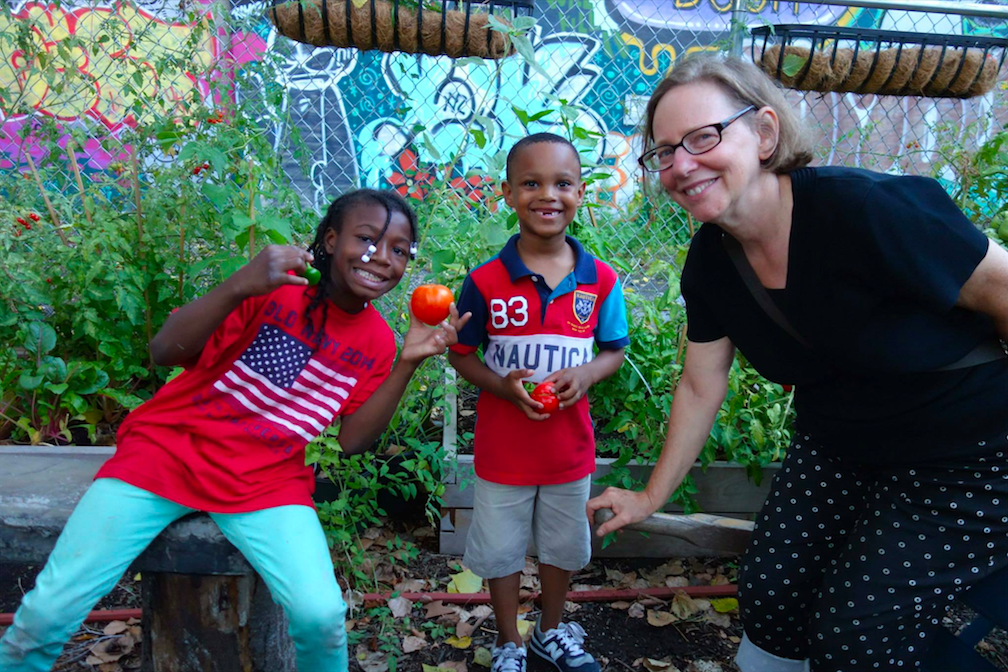
Wendy Brawer with young neighbors at Siempre Verde Community Garden, NYC
Mapping a Hopeful Future: Wendy Brawer's work bridging art and policy through her non-profit Green Map System.
Interview by Olivia Ann Carye Hallstein
Wendy Brawer goes beyond the confines of a art-denoted space and onto the streets, in government offices and directly to communities to fight for climate related justice. Her role as a "social sculptor" creates paths for collaboration and community empowerment. By holding both idealism and pragmatic change, her non-profit Green Map System® allows organized agency as well as a connected community that honor efforts towards a greener future for all.
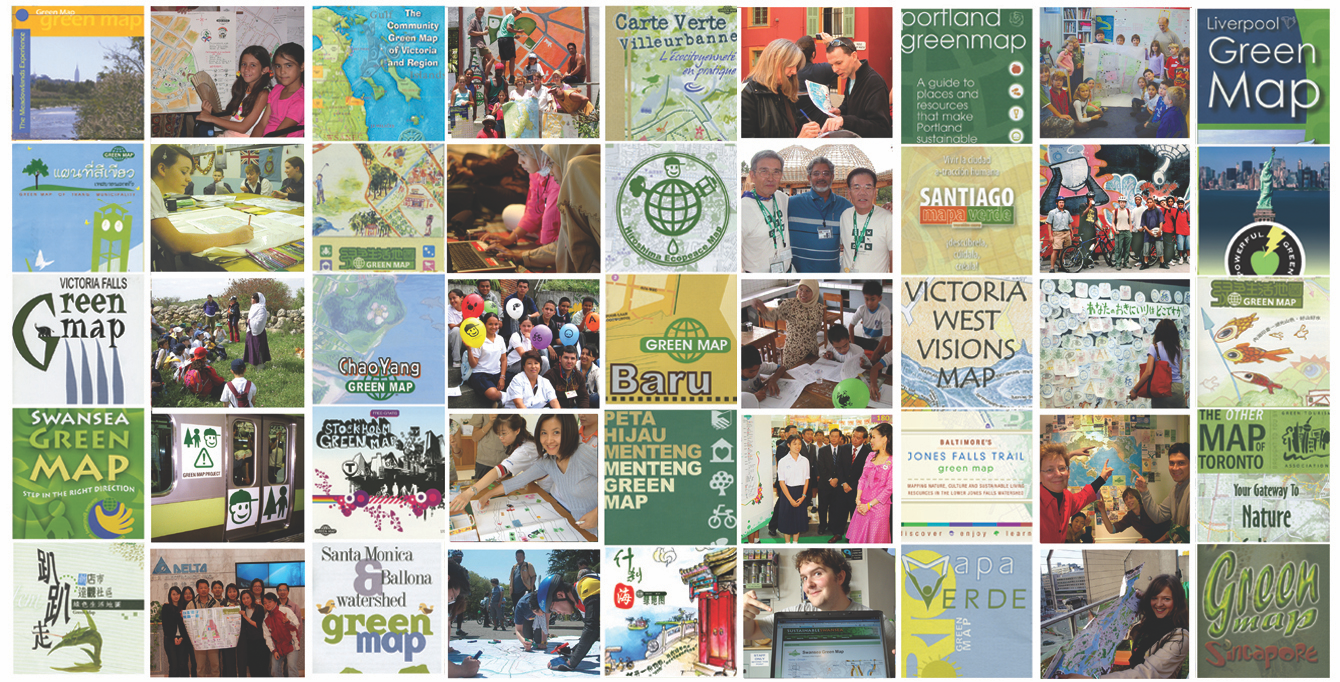
A collage of locally published Green Maps reflects diversity of place, style and considerations
Hi Wendy, I am especially interested in how your “Green Maps” work bridges a divide between artistry and planning. How do collaborative art and visual formats allow people to create practical change? Where does the art begin and the organizing end?
Green Map making blends and enhances many skills that artists have around observation, interpretation, and changing perspectives. Maps have an ancient power that communicates the complexities of place—in this case, your home place. Organizing people, processes and places yields significant data alongside the visual expression. This medium builds capacity for our common future and helps us notice change (or the lack thereof) while activating and informing people who use or make each Green Map.
Artists, changemakers, educators and groups can use Green Map System’s open source mapping platform for free—it’s easy and it’s designed to engage diverse voices in the process. Or you can make a printed Green Map, a mural, video, performance or experience. Share your viewpoint on local climate challenges and solutions by highlighting and linking exemplary places and projects on your Green Map.
I’m a ‘social sculptor’ who blends art and organizing. Wikipedia says: As a work of art, a social sculpture includes human activity that strives to structure and shape society or the environment. The central idea of a social sculptor is an artist who creates structures in society using language, thoughts, actions, and objects.

The ongoing Green Map project at University of Victoria BC Canada often hosts international students, like this group from China, 2015
Social sculptor, what an incredible term! It really bridges this artmaker-organizer divide. Beginning as a personal project, your work has grown to become an award-winning non-profit organization with work in 65 countries. What have been some of the more rewarding and frustrating moments of being a founder and expanding internationally?
Like most people whose heart decides where creative energy is directed, I was an artist long before I shifted towards ecodesign and experienced the excitement of solo shows, commissioned work and the competitive art world, mainly in Seattle. Even then, I preferred to work collaboratively, and often used found and recycled objects in my mixed media work. My partner and I were on the adventure path and headed west to live in Tokyo, drifting to NYC’s Lower East Side a couple of years later.
A pivotal moment and an honor above all came to me from an entrapped Orangutan who threw me a stone. I caught it and turned green—that was 1989 and the start of my work for our common future.
I blurred the art and design boundary and became an eco encouragement agent. This led to my being appointed Designer in Residence at the Smithsonian Cooper-Hewitt National Design Museum (1997), Honorary Citizen of Japan (2004), Climate S’hero (2013), LES Neighborhood Hero (2016), TED Resident (2017) and most recently to the board of a favorite place, the Trust for Governors Island (2023).
The cycles of sustainable development seem to have square wheels and the crawl toward climate stability is a key frustration—what can we do to take down barriers to action? At Green Map, this reality led our nonprofit to go open source in 2018, providing tools and support free, on a share-alike basis. Thus, climate urgency opened the door to new collaboration, innovation and inspiration, attracting partners like the GIS Collective and the POP shop to the Green Map Platform team.

A living lexicon, Green Map’s shared set of icons have evolved since 1995 and were recently linked to the United Nations 17 Global Goals (the SDGs)
And the list of collaborators goes on. You have even integrated the United Nations “17 Global Goals” through the “Green Map Icons” that help denote specific points of international interest. How has the integration of these icons changed the way you are able to work with these maps? Or collaborate between communities?
The SDGs are a profound framework, but generally invisible in NYC, despite the UN being anchored in midtown. Could our tools and methods help people connect with the intersections they illuminate? Sadly, not so much! We even created an event to bring local and UN folks together, hoping to spark some synergy, and followed the trail in places like Copenhagen, Geneva and Japan’s Azabu University where local Green Mapmakers were germinating and inspiring new integrations (see slides). The tiny wave we were generating was disrupted in 2020, for which we created Recovery Icons, which are now morphing into a set of social service icons that touch on some of the SDG themes.
A notable update: Scotland’s Coalfields Regeneration Trust is mapping with several rundown communities, turning the Green Map into a Local Place Plan, a national program created in 2019 which contains a new right for communities to produce their own plans. This year, our icons and ethos are meshed with the SDGs and the Earth Charter by the Coalfields Regeneration Trust. Our mission-aligned tools unlock creativity and expression, so important to the uptake of this programme.
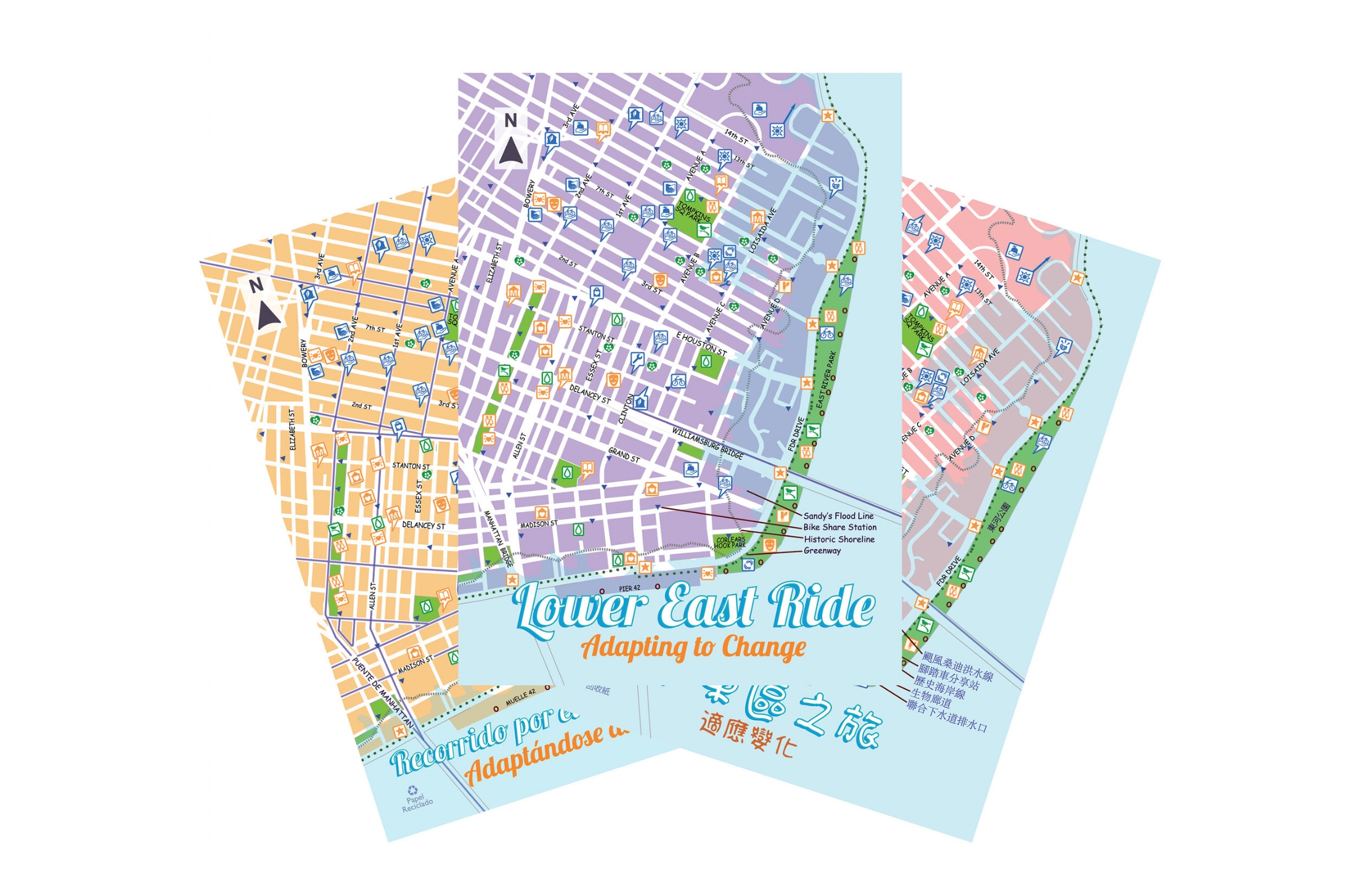
Lower East Ride was created in Chinese, Spanish and English to support bicycling as an everyday climate change countermeasure on the Lower East Side of NYC in 2013
It's like a structure for people to bounce off of and express their individual needs. In a way, your maps provide an open platform for individual self-regulation among communities who are interested in the environmental infrastructure. Have the maps had lasting influence in planning and policy making in these spaces? Have grassroots organizers and local educators used these tools to support their concerns?
Last month, I was excited to see a social post from Jahu Brasil. Their print Green Map, made twenty years ago, became the basis of the master plan— now they are ready to create a new one! There are other places which have used our adaptable tools to frame a vision of what is possible and to set new policies.
From Jakarta, architect-planner Marco Kusumawijaya announced his three-volume masterwork this season. In response to my asking, he replied, “Yes the book is the first to compile so much information on Indonesian cities (also from personal direct experiences). And yes, some are from the Green Map experiences that led me to investigate further.” Marco’s 2002 Jakarta Green Map was the first requested by a President for her cabinet. Peta Hijau workshops yielded a dozen local projects across the archipelago, including Yogyakarta, where the Orangutan encounter that slapped sense into my palm was mapped. Marco’s Banda Aceh ‘memory map’, co created with survivors of the 2004 tsunami, became a blueprint for redevelopment that won the Dubai Prize, and sparked other crisis Green Map.
We also see projects like Red de Mapa Verde, which has impacted communities all across Cuba as a great example of grassroots organizing and educators manifesting change. We love how Mapa Verde is used as a diagnostic tool there and how the project leaders at Centro Felix Varela have shared their approach in several books and at conferences since 2000. Liana Cisneros Bidart and colleagues have contributed greatly to our understanding of what a Green Map project can do.
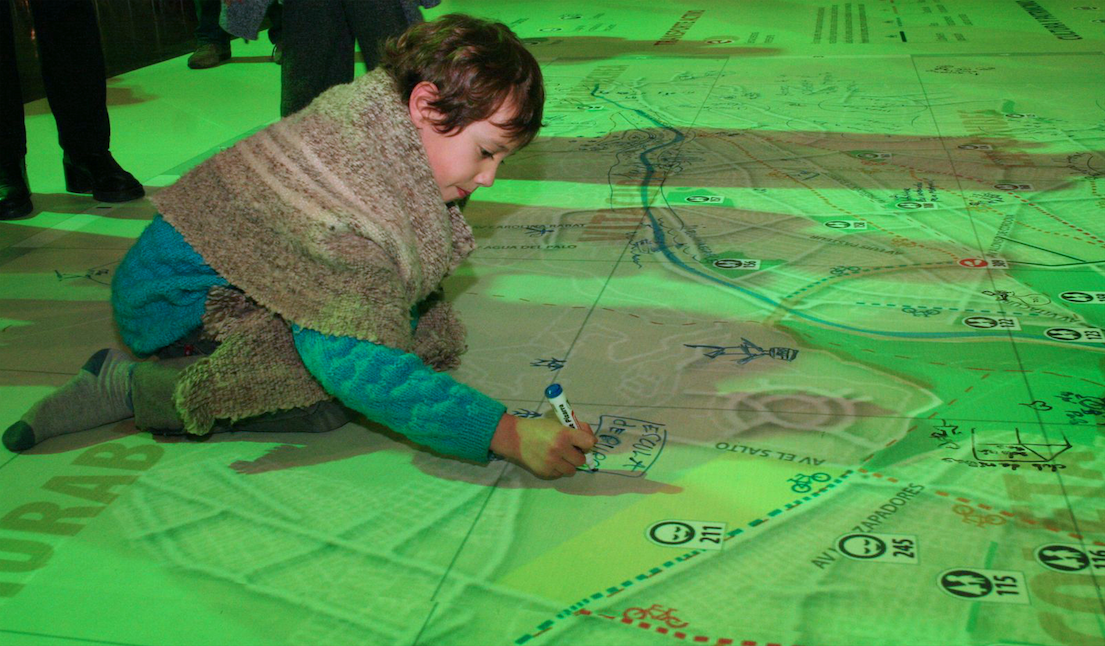
Young participant at the Santiago Mapa Verde launch in Chile
It is so inspiring to hear the lasting effects of this project and its practical applications. The agency that Green Map System allows for communities to self-determine both content and presentation of their maps has created such variety in responses. What did you factor in when creating a framework that would both set up reasonable structures and rules to follow while allowing enough freedom to promote creativity and individuality?
I had already published two NYC Green Maps and was invited to the UN Social Summit of 1995 to present on the Greening of NYC—and happily this catalyzed a meeting of the emerging O2 Global network of ecodesigners. We all threw ideas on the table and mine was to co-create a set of sustainability icons to be used to help identify, promote and link disparate Green Map made locally, and to create a movement that would share mapmaking experiences. A modem was tossed into the mix and voila, developing Green Map System became our first internet collaboration—there’s a story here.
We had a whole new medium—how could we use the web democratically to discover local green living resources and the nature, cultural and social justice realities of home? O2’s influence remains strong.
I wrote this article The Web as a Metaphor as I co-created the system, its first website and interactions. We have always tried to be open and inclusive. 125 interns have pitched in, and one of the first, David Campbell, suggested turning the icons into a font that would work with any computer application, thus leveling the Green Map playing field in 1996. I was influenced by the gift economy of indigenous people—I had learned about potlatches in the Pacific Northwest long before I heard of open source development and how to work together fluidly. I also want to credit community gardeners and how they work autonomously and together. We even named our first content managed website ‘the Greenhouse’ as it nurtured diverse and verdant ‘gardens’ around the world.
On the topic of diversity, autonomy and togetherness, I want to point our the term “glocal” that your website uses. It's a personal favorite term and has really shifted my perspective as a practitioner. What does “glocal'' mean to you and to your mission? What is it that the combination of local and global promotes especially well?
Think global, map local. Observe through this lens and share your perspective. My guiding principle since 1995! Encapsulating it all, glocal considers impacts on both your home place and planet.
Glocal is an activating, inclusionary term. The benefits of going local are a given now, and part of the reason I keep working on NYC projects, ranging from the Dutch Kills Loop, a proposed land regeneration and infrastructure reuse project in Long Island City to the return of the Stanton Parkhouse to community use on the Lower East Side. I show up for causes and pitch in around air quality, open streets, street trees, community gardens and more.
Our world needs glocal—the free flow of capabilities, knowledge and networks from place to place, so we can seed a world where dignity and sufficiency for all forever can be imagined and co-created.
Thank you for sharing your story, and of course, ecoartspace readers are welcome to become Green Mapmakers, too—see GreenMap.org
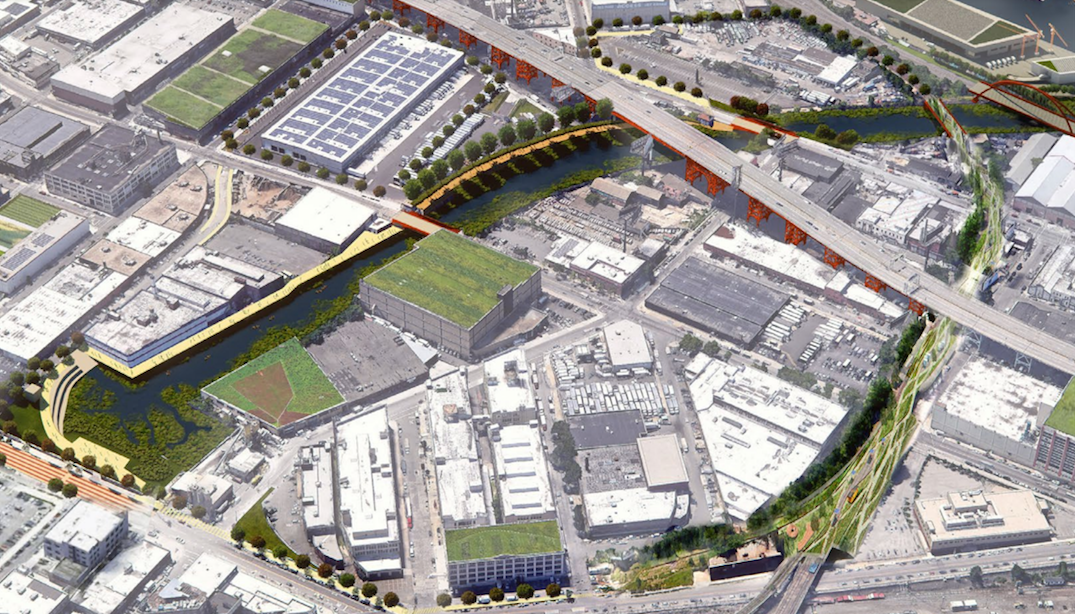
Green Map is on the planning team at the Dutch Kills Loop, a land regeneration and infrastructure reuse project in Long Island City